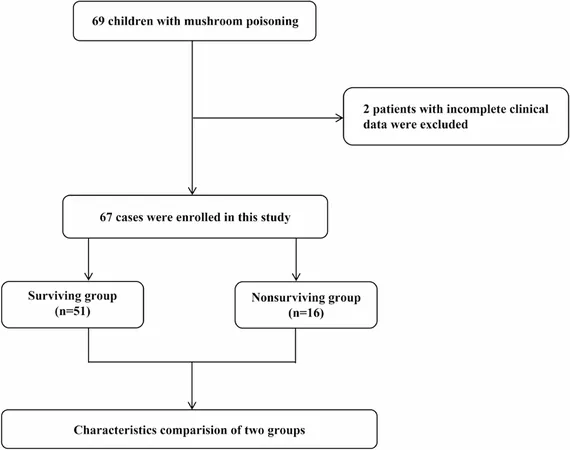
Mushroom Poisoning in Children: High Risks and Prognostic Insights
2025-06-17
Author: Nur
A Growing Concern: Mushroom Poisoning in Children
Mushroom poisoning is emerging as a serious health risk for children, especially in regions where wild mushroom consumption is common. A new study from Chongqing, China, highlights alarming statistics on mortality and risk factors associated with mushroom poisoning in pediatric patients.
Study Overview: Understanding Mortality Rates
Researchers examined the cases of 67 children hospitalized for mushroom poisoning between 2012 and 2023. The results revealed a staggering mortality rate of 23.88%. Shockingly, the incidence of death during hospitalization was 35.02 per 1,000 person-days.
Identifying Risk Factors: The Pediatric Sequential Organ Failure Assessment (pSOFA) Score
Utilizing clinical data, the study found that the Pediatric Sequential Organ Failure Assessment (pSOFA) score was a significant predictor of mortality. Children with a pSOFA score of 2 or higher faced nearly five times the risk of death, underscoring the importance of early assessment and intervention.
Symptoms and Hospitalization: A Closer Look
Common symptoms in children included abdominal pain, vomiting, and diarrhea, with some exhibiting severe conditions like coma and seizures. Most children presented to the hospital approximately three days post-consumption, highlighting the critical need for timely medical intervention.
The Importance of Prompt Treatment
The findings suggest that delays in seeking medical help significantly worsen outcomes. Children who took longer to reach the hospital had a higher mortality rate, emphasizing the need for immediate treatment following suspected mushroom ingestion.
Connecting the Dots: Understanding Toxicity and Outcomes
The complexity of mushroom poisoning stems from the variety of toxic mushrooms that can cause varying degrees of harm, particularly to the liver and kidneys. The study advocates for heightened education around identifying poisonous mushrooms and urgent medical protocols to treat affected children.
Future Directions: Bridging Knowledge Gaps
While this study sheds light on the severity of mushroom poisoning in children, it also calls for more extensive, multi-center research to better understand the specific impacts of various mushroom species and the effectiveness of treatment methods. As awareness grows, so does the urgency to prevent such tragedies.
Conclusion: A Call for Awareness and Action
Mushroom poisoning is not just a seasonal threat; it poses a significant, ongoing risk to children's health. With effective education, prompt diagnosis, and a focus on systematic treatment protocols, the mortality associated with mushroom poisoning can hopefully be reduced.



 Brasil (PT)
Brasil (PT)
 Canada (EN)
Canada (EN)
 Chile (ES)
Chile (ES)
 Česko (CS)
Česko (CS)
 대한민국 (KO)
대한민국 (KO)
 España (ES)
España (ES)
 France (FR)
France (FR)
 Hong Kong (EN)
Hong Kong (EN)
 Italia (IT)
Italia (IT)
 日本 (JA)
日本 (JA)
 Magyarország (HU)
Magyarország (HU)
 Norge (NO)
Norge (NO)
 Polska (PL)
Polska (PL)
 Schweiz (DE)
Schweiz (DE)
 Singapore (EN)
Singapore (EN)
 Sverige (SV)
Sverige (SV)
 Suomi (FI)
Suomi (FI)
 Türkiye (TR)
Türkiye (TR)
 الإمارات العربية المتحدة (AR)
الإمارات العربية المتحدة (AR)